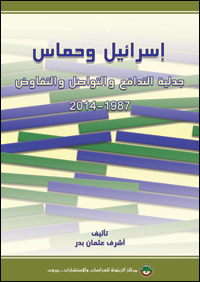Al-Zaytouna Centre has published a new book entitled, “Israel and Hamas: The Dialectic of Mutual Restraining, Communication and Negotiations 1987–2014.” It addresses the communication and negotiations between the Israel and Hamas by exploring the dialectic of direct and indirect negotiations, related to either prisoner exchange deals, or to negotiations inside prisons. This book explores the Israeli strategies and policies towards Hamas, in general, and the negotiations with it, in particular.
The 148-page book begins with a brief preface that explains the factors that contributed to Hamas’s adoption of the revolutionary resistance approach, and the stages that the Palestine issue went through until 14/6/2007. The first chapter deals with the Israeli security and political strategy, in addition to Israel’s policy in dealing with Hamas, while the second chapter discusses the direct and indirect negotiations that took place between Israel and Hamas. This book contains an appendix of two documents; the first is Ahmad Yusuf’s proposal to set the suitable conditions to end the conflict, and the second is the ceasefire agreement of the Protective Edge war.
| Click here to download: Chapter 2 (Arabic) |
In this book, the author relied on interviews as a research tool to learn more about how Israel has dealt with Hamas, and understand the positions of Israel and Hamas towards negotiations.
The book concluded that after Israel having several military confrontations with the Palestinian resistance factions, including Hamas, it concluded that a complete victory cannot not be reached. Therefore, it was satisfied with achieving limited victory that provides a period of security calm. Moreover, the Israeli policy towards Hamas is affected by two important variables: the first is the policies of the Israeli prime minister, and the second is the regional political climate. However, there was always an Israeli satisfaction with the state of schism and Israel has sought relentlessly to consolidate it.
The book concluded that both sides, Israel and Hamas, do not believe that it is possible to reach a final solution to the Palestine issue, therefore, their interests converged in reaching immediate security agreements without reaching a political solution. Israel does not wish to “concede” anything to the Palestinians, and there is nothing to force it to do so, while Hamas believes that in light of the imbalance of power in favor of Israel, it is better for the Palestine issue to keep the conflict open and resort to temporary solutions, like the armistice, without recognizing the right of Israel to exist.







 ||
||

Leave A Comment